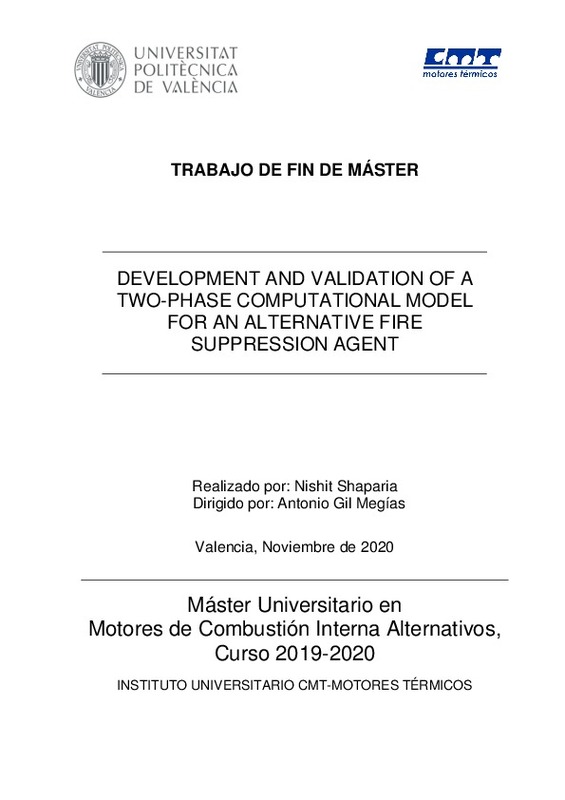JavaScript is disabled for your browser. Some features of this site may not work without it.
Buscar en RiuNet
Listar
Mi cuenta
Estadísticas
Ayuda RiuNet
Admin. UPV
Development and validation of a two-phase computational model for an alternative fire suppression agent
Mostrar el registro sencillo del ítem
Ficheros en el ítem
| dc.contributor.advisor | Gil Megías, Antonio
|
es_ES |
| dc.contributor.author | Shaparia, Nishit Rajeshkumar
|
es_ES |
| dc.date.accessioned | 2020-12-19T01:02:36Z | |
| dc.date.available | 2020-12-19T01:02:36Z | |
| dc.date.created | 2020-11-26 | |
| dc.date.issued | 2020-12-19 | es_ES |
| dc.identifier.uri | http://hdl.handle.net/10251/157474 | |
| dc.description.abstract | [ES] Halon1301 se ha utilizado como agente de extinción de incendios en sistemas activos de extinción de incendios en motores de aviones, APU (Unidad de potencia auxiliar) y protección contra incendios de carga durante más de 50 años. En 1987, una investigación realizada por el Protocolo de Montreal muestra que Halon está dañando el medio ambiente debido a sus propiedades que agotan el ozono. Por lo tanto, el uso de gases de halón ha sido prohibido en la industria por el protocolo de Montreal (1994) y Kyoto (1998). Por lo tanto, es el reemplazo de gases de halón lo que es más ecológico. Entre estas alternativas, Novec-1230 es una alternativa sostenible que funciona de manera rápida, limpia y eficiente. El sistema de extinción de incendios requiere que se diluya una concentración específica del agente de extinción de incendios (4-6% para Novec-1230 y 5% para Halon) en el aire para extinguir el fuego. El problema de cambiar la fase de la niebla rápidamente despresurizada de un sistema de extinción de incendios es un tema de gran interés debido al efecto del modelado de estos fenómenos en una simulación exitosa para diseñar estas modificaciones. Debido a la gran diferencia de presiones entre el recipiente y el ambiente, se espera que la descarga a través de la boquilla sea crítica. En este informe, se utilizan dos agentes de supresión de incendios alternativos diferentes y dos boquillas: agua y Novec1230. El objetivo principal de este proyecto es desarrollar un nuevo modelo de subcuadrícula para un U-RANS CFD Euleriano-Euleriano de dos fases que pueda usarse para reducir el costo computacional y aumentar la precisión de los enfoques tradicionales basados en Eulerian-Lagrangian. Estos dos enfoques se realizan con el software comercial CFD (ANSYS Fluent). Como validación, los rendimientos de pulverización como la forma de pulverización, el ángulo del cono de pulverización se comparan con los resultados experimentales. | es_ES |
| dc.description.abstract | [EN] Halon1301 has been used as a fire suppression agent in active fire extinction systems in aircraft engines, APU (Auxiliary Power Unit) and cargo fire protection for more than 50 years. In 1987, a research carried out by the Montreal Protocol shows that Halon is damaging the environment because of its ozone-depleting properties. Therefore, the use of Halon gases has been banned in the industry by the Montreal (1994) and Kyoto (1998) protocol. So, it is indeed to find replacement of halon gases which is more eco friendly. Among these alternatives, Novec-1230 is a sustainable alternative that works quickly, cleanly and efficiently. The fire suppression system requires a specific concentration of the fire suppression agent (4-6 % for Novec-1230 and 5% for Halon) to be diluted in the air to extinguish the fire. The problem of changing the phase of the rapidly depressurized mist of a fire suppression system is a topic of high interest due to the effect of the modelling of these phenomena in a successful simulation to design these modifications. Due to the high difference of pressures between the container and the ambient, the discharge through the nozzle is expected to be critical. In this report, two different alternative fire suppression agents and two nozzles are used - Water and Novec1230. The main goal of this project is to develop a new sub-grid model for a two-phase Eulerian-Eulerian CFD U-RANS that can be used to reduce the computational cost and increase the accuracy of traditional approaches based on Eulerian-Lagrangian. These two approaches are performed with CFD commercial software (ANSYS Fluent). As validation, spray performances such as spray shape, spray cone angle are compared with experimental results. | es_ES |
| dc.format.extent | 51 | es_ES |
| dc.language | Inglés | es_ES |
| dc.publisher | Universitat Politècnica de València | es_ES |
| dc.rights | Reserva de todos los derechos | es_ES |
| dc.subject | Computational fluid dynamics (CFD) | es_ES |
| dc.subject | Atomization | es_ES |
| dc.subject | Computational models | es_ES |
| dc.subject | Fire suppression agent | es_ES |
| dc.subject | Computational fluid dynamics | es_ES |
| dc.subject | Multiphase | es_ES |
| dc.subject | Atomización | es_ES |
| dc.subject | Multifásico | es_ES |
| dc.subject | Euler-Euler | es_ES |
| dc.subject | Euler-Lagrangian | es_ES |
| dc.subject | U-RANS | es_ES |
| dc.subject | ANSYS-fluent | es_ES |
| dc.subject.classification | MAQUINAS Y MOTORES TERMICOS | es_ES |
| dc.subject.other | Máster Universitario en Motores de Combustión Interna Alternativos-Màster Universitari en Motors de Combustió Interna Alternatius | es_ES |
| dc.title | Development and validation of a two-phase computational model for an alternative fire suppression agent | es_ES |
| dc.type | Tesis de máster | es_ES |
| dc.rights.accessRights | Abierto | es_ES |
| dc.contributor.affiliation | Universitat Politècnica de València. Departamento de Máquinas y Motores Térmicos - Departament de Màquines i Motors Tèrmics | es_ES |
| dc.description.bibliographicCitation | Shaparia, NR. (2020). Development and validation of a two-phase computational model for an alternative fire suppression agent. Universitat Politècnia de València. http://hdl.handle.net/10251/157474 | es_ES |
| dc.description.accrualMethod | TFGM | es_ES |
| dc.relation.pasarela | TFGM\129363 | es_ES |






